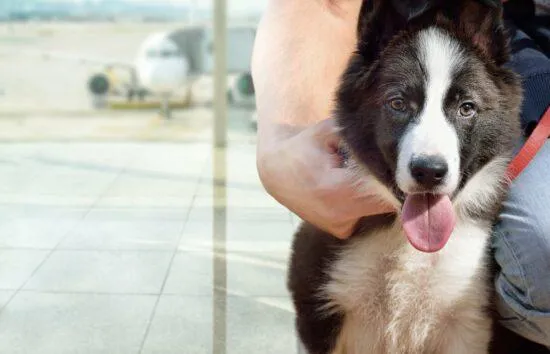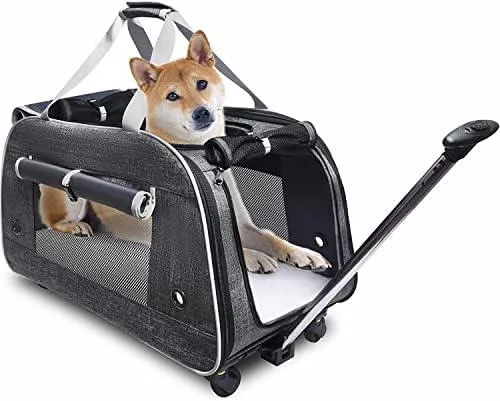Can Large Dogs Fly in Aircraft Cabins?
As a frequent flier with dogs, one of the most common questions I get asked is whether or not large dog breeds can join their owners in the main cabin on commercial flights. Let’s break down the key considerations to help answer this question.
Airline Size and Weight Restrictions
Most major airlines in the U.S. allow dogs to fly in the cabin, but they impose size and weight limits. The typical maximums are:
- Size: The dog must be able to sit on your lap or fit under the seat in front of you in its carrier without sticking out into the aisle.
- Weight: Dogs are usually limited to 20 pounds or less.
So generally, large dog breeds like Great Danes, Mastiffs, Saint Bernards, etc. that exceed these limits would notqualify to bring in the cabin based purely on size.
Modifications and Special Provisions
However, some airlines do make exceptions and allow larger dogs onboard with a veterinarian’s note. The note needs to verify the dog is healthy and well-trained enough to behave properly in the confined space of a plane for the duration of the flight. Some carriers may also require the dog to be crated in a hard-sided kennel that secures under the seat.
Alternatively, you could purchase an extra seat or two for the dog to have its own space. But this adds significant cost to the ticket. From my experience, it’s rarely practical or worth it financially for most owners of giant breeds.

Cargo Hold Is the Only Option
If Fido is simply too big to squeeze into the cabin according to the rules, then the cargo hold is the only remaining choice. However, this presents its own challenges.
- Conditions are not climate-controlled like the cabin. Temperatures can fluctuate drastically.
- There’s increased risk of injury if the dog is not properly secured in a sturdy kennel designed for air travel.
- You cannot directly monitor or attend to your dog during the flight like you could in the cabin.
Recent incidents of dogs dying or being lost in cargo compartments have also increased public scrutiny over this method. As a dog owner, it may cause stress and anxiety not being right by their side.
Is Flying Really Best?
Given these complications, one must seriously consider whether air transport is practical or safe for a giant breed dog. Some potential alternatives to examine:
- Driving, even if very long distances, may be preferable if you have someone to switch off with.
- Taking a train if possible could allow you to stay with your dog in a private cabin or carriage the whole way.
- Seeking ground transportation services that specialize in animal relocation across states.
In a pinch, delaying the trip a few months until your dog is small enough to fit regulations may be better than subjecting them to risks of flying oversize. Patience and safety should come first when pets are involved.
Bringing Emotional Support Animals
One loophole some utilize is registering their large dog as an emotional support animal (ESA) so it can accompany them in the cabin freely. While this designation aims to help people with disabilities, it has led to abuses lately.

Airlines are cracking down and scrutinizing illegitimate ESA requests more closely. To qualify, a medical professional must deem the owner truly requires the animal for diagnosed mental health conditions. Simply wanting companion on a flight won’t cut it. As an owner, seriously consider if an ESA status is being misused in your case.
So in short – while bringing big dogs on planes seems tempting, safety should be the top priority when traveling. For most giant breeds, check-in or ground transport are better options. But you’ll need to plan well ahead and be flexible.
What’s Been Your Experience?
I’ve personally found driving to be way more hassle-free for my Saint Bernard rather than dealing with aircraft rules and risks. How about you – have you faced any struggles flying with large dogs? I’m curious to hear real-life case stories from other pet owners out there. Feel free to share your experiences in the comments below!
I hope this breakdown of the key factors has been helpful in providing a clearer picture of whether large dogs can in fact join you in airplanes. Let me know if any other aspects need further explanation. Safe travels to all pet parents out there!
Large Dog Air Travel Requirements
| Airline | Weight Limit | Crate Requirement |
|---|---|---|
| Delta | 70 lbs | Hard-sided crate |
| United | 100 lbs | Soft-sided crate |
| American | 50 lbs | Hard-sided crate |
| Alaska | 75 lbs | Soft-sided crate |
| JetBlue | 50 lbs | Hard-sided crate |
FAQ
-
Can large dogs sit in the cabin on airplanes?
Mostly yes, large dogs can fly in the cabin as long as they meet the airlines size and weight limits. They usually need to fit under the seat in a carrier.

-
What are the size limits for dogs on planes?
The maximum size is usually around 20 inches tall and no heavier than 20 pounds or so. However, different airlines can have slightly varying rules. It’s best to check the specific requirements for your airline.
-
Won’t a big dog be too rowdy in the small plane space?
While it may seem like a big dog would cause problems, many large breeds are actually quite calm and well-behaved. Of course, the dog’s temperament matters most. As long as they can settle down for the flight without disturbing others, most large dogs fly just fine in the cabin.
-
What if my big dog is over the size limit?
If your large dog exceeds the maximum dimensions, you’ll probably need to check them in a larger crate in the cargo hold. That seems less than ideal for the dog’s comfort. But there might be some exceptions made for service animals. Overall it depends on the specific airline rules.
-
Aren’t there risks sending a dog in the cargo hold?
You do of course want to avoid putting an animal in any dangerous situation. However, many experts say that modern pressurized cargo compartments are actually quite safe when proper protocols are followed. Perhaps the dog would still feel more secure in the cabin where their owner is nearby.
- At the same time, the cargo area may be a dog’s only option if they are too big. And plenty of large breeds fly down below without trouble. As long as the animal is healthy, the temperature is properly regulated, and handlers take extra care, cargo transport can work out alright for big dogs too on occasion. It just requires a bit more risk that some pet parents might rather avoid if possible.
Overall, whether flying in cabin or cargo, the most important things are making sure your large dog is comfortable, secure, and not causing problems for others. Most airlines will work with you within reason to safely transport man’s best friend. But checking requirements ahead of time prevents confusion or issues down the line. With a little preparation, even big dogs can enjoy air travel.

